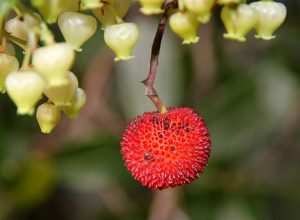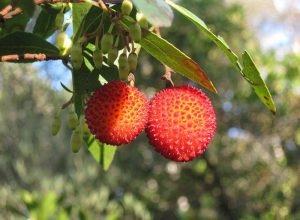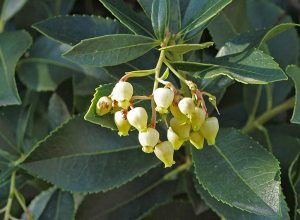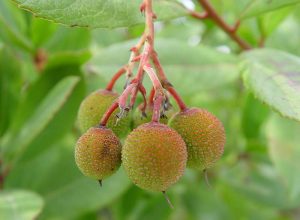Strawberry Tree – Arbutus Berry


Originally from the Mediterranean basin and the Atlantic coast and as far as the southern shores of Ireland, belonging to the heather family, like our common heathers, the Strawberry tree is a robust shrub or a small tree that often reaches ten meters in height. This plant is a symbol of Sardinia, we can find this evergreen rustic along the sun kissed and barren coastal slopes, where it can reproduce itself easily and imposes itself on other species.
Although it appreciates hot climates, it can also grow and develop in relatively low temperatures; it’s no coincidence that we find it spontaneously at high latitudes like those in Ireland, but also in the Po Valley with its continental climate, with very cold and damp winters and torrid summers it can prosper and bear fruit. Instead, it dislikes, damp and cold winds and altitudes above 500/800 meters.
The strawberry tree lends itself well to be positioned in our gardens with lovely dark green lanceolate and slightly jagged leaves; at the same time the flowers come into bloom, we can find the fruit ripening and, in autumn, also the mature ones and we can see the trunk, that most of the time is multiple, with a thin and pretty bark that completes a very pleasant whole.
TERRAIN
As its part of the heather family, it prefers acid soils, but it also tolerates those with a high ph. Very damp and stagnating soils should be avoided. In loamy and compact soils that are drenched by frequent rain, like those of the Po Valley, it’s best to plant the Strawberry tree in places that are sheltered, like against a wall or under a ledge.


FLORA AND FRUIT
From the bloom to the harvest, the Strawberry tree has a very particular path. From October to December, at the apices of the small branches, small bunches of white flowers appear, that have pollinated themselves, rounded, green, covered with minute tubercles that will remain even when, in late autumn, in conjunction with the new bloom, they will reach, with the full ripening, a wonderful vivid red colour.
In the same plant, you often find, white flowers, unripe green fruit, orange fruit in the ripening phase and the ripened red ones: peculiarity that makes the Strawberry tree an extraordinarily ornamental plant.
Unfortunately, such a late blooming period, if disturbed, especially by cold winds, could bring a poor production of fruit. The flowers are very melliferous and a slightly bitter honey is obtained, aromatic and energetic; unfortunately, in case of premature cold weather, the bees are not always working during the blooming period, and consequently, this type of honey is quite rare. Very sought for is the honey produced on the Sardinian hills.
USE AND HEALTH PROPERTIES
The use of the fruit that has just been picked, although very sweet, is very modest; more frequent, instead, is to find it transformed into jams, syrups, juices, candied and distillates.
The qualities of the Strawberry tree are not much, but relevant. It’s the most secure and efficient medicinal plant, it’s use is consolidated, for treating urinary tract infections, like cystitis, prostate issues and urethritis. It also plays an important astringent action.
Due to the high level of tannins, the trunk is used for tanning of skins and for the extraction of dyes.
PRUNING AND CULTIVATION
A plant with a fast development to be used for anti-erosive reforestation, pruning is mostly carried out to contain the growth and give a pleasant aesthetic appearance. A thinning intervention will surely be needed to have less fruit, but better ones.
Watering is necessary only when planting, and once positioned only in case of extreme drought.
Due to the rapid growth, both when implanting and when positioned, it’s better to give it an adequate intake of mature organic substance that will allow it to, prevent attacks from fungi and bacteria.
If manured well and with drenched soil, the Strawberry tree is hardly attacked by fungus disease. If it should happen, a treatment with a copper product will do to kill the disease.
Unfortunately, it’s essence is very much appreciated by the annoying strawberry root weevil, with peculiar weather conditions attacks from aphids can occur, that are easily killed with a biological insecticide; rare, instead, are attacks from matacafta and cochineal.
